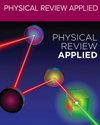Electron cooling behavior in cascading semiconductor double-quantum-well structures
IF 4.4
2区 物理与天体物理
Q2 PHYSICS, APPLIED
引用次数: 0
Abstract
We investigate evaporative electron cooling in cascading semiconductor double-quantum-well (QW) structures. In this cascading double QW structure (QW1 and QW2, where QW2 is on the anode side), one electron absorbs two longitudinal optical (LO) phonons as it travels from the cathode to the anode, for which efficient thermionic cooling is expected. By analyzing the high-energy tail of the photoluminescence spectra, the electron temperature in each QW is determined. When barriers are used, anomalous electron heating in QW2 due to hot electron distribution above the barrier is observed. By introducing taller barriers () before QW2 to suppress hot electron distribution above the barrier, electron cooling in both QWs by several tens of kelvins is achieved. Furthermore, oscillatory anticorrelated electron temperature change in the two QWs that results from LO-phonon scattering is observed.

级联半导体双量子阱结构中的电子冷却行为
我们研究了级联半导体双量子阱(QW)结构中的蒸发电子冷却。在这种级联双量子阱结构(QW1 和 QW2,其中 QW2 位于阳极侧)中,一个电子在从阴极到阳极的过程中会吸收两个纵向光学(LO)声子,因此有望实现高效的热离子冷却。通过分析光致发光光谱的高能尾部,可以确定每个 QW 中的电子温度。当使用 Al0.35Ga0.65As 势垒时,由于势垒上方的热电子分布,在 QW2 中观察到异常的电子加热现象。通过在 QW2 之前引入较高的势垒(Al0.7Ga0.3As)来抑制势垒上方的热电子分布,两个 QW 中的电子冷却了几十开尔文。此外,还观察到两个 QW 中因 LO 光子散射而产生的振荡反相关电子温度变化。
本文章由计算机程序翻译,如有差异,请以英文原文为准。
求助全文
约1分钟内获得全文
求助全文
来源期刊

Physical Review Applied
PHYSICS, APPLIED-
CiteScore
7.80
自引率
8.70%
发文量
760
审稿时长
2.5 months
期刊介绍:
Physical Review Applied (PRApplied) publishes high-quality papers that bridge the gap between engineering and physics, and between current and future technologies. PRApplied welcomes papers from both the engineering and physics communities, in academia and industry.
PRApplied focuses on topics including:
Biophysics, bioelectronics, and biomedical engineering,
Device physics,
Electronics,
Technology to harvest, store, and transmit energy, focusing on renewable energy technologies,
Geophysics and space science,
Industrial physics,
Magnetism and spintronics,
Metamaterials,
Microfluidics,
Nonlinear dynamics and pattern formation in natural or manufactured systems,
Nanoscience and nanotechnology,
Optics, optoelectronics, photonics, and photonic devices,
Quantum information processing, both algorithms and hardware,
Soft matter physics, including granular and complex fluids and active matter.
 求助内容:
求助内容: 应助结果提醒方式:
应助结果提醒方式:


